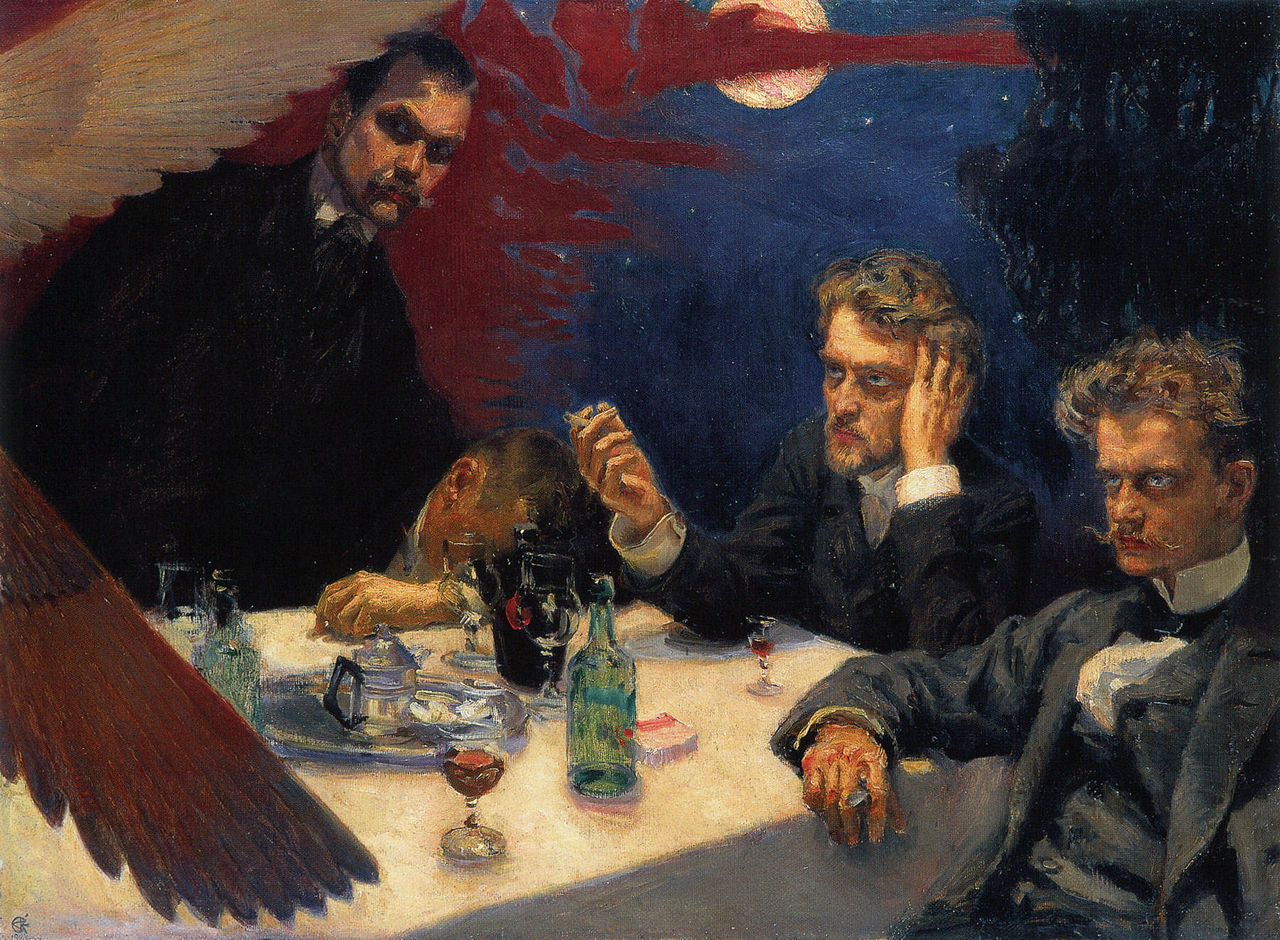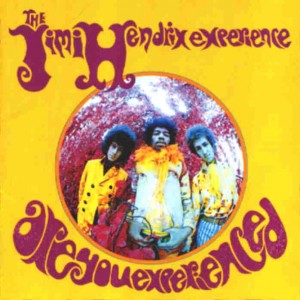19922. (Syd Barrett) You Got It Now [rare European bootleg LP]
19923. (Thomas Tallis) In nomine I
19924. (Thomas Tallis) In nomine II
19925. (Thomas Tallis) A Solfing Song
19926. (Thomas Tallis) Salvator Mundi [version for strings] Read more »
Category Archives: CM - Listening 2009 - Page 3
First-time listening for May, 2009
Elk Whistle: Still With Us / Wambdi Hokshida
Elk Whistle [aka Elk Whistle Singers] hale from Regina, Saskatchewan. This album would be classed as “pow pow contemporary” rather than “traditional”, sung in the Northern Style, with considerable improvisational freedom. It’s an example of the fine material being released by Saskatoon-based Turtle Island Music.Outstanding is the lead-in “Victory Song”.
Sibelius Symphony #1

Akseli Gallen-Kallela’s painting Symposium made in 1894. Symphony #1 was completed in 1899. From left: Akseli Gallen-Kallela, Oskar Merikanto, Robert Kajanus and Jean Sibelius. They were a clique of young bon vivants in Helsinki. Sibelius had already developed his trademark scowl. Kajanus would conduct the symphony.
Jean Sibelius’s Symphony No. 1 in E minor, Opus 39 was written in 1898, and first performed the next year. Sibelius was aged 33, but he had been composing seriously for less than ten years. The seven symphonies constitute a corpus of work that begins with the conventional symphonic form and gradually evolves into an entirely different approach. Standing at the beginning of this process, the First is essentially conventional in form. Its resemblance to Tchaikovsky’s symphonies is so obvious that most listeners will spot it instantly, but it also displays many of Sibelius’ distinctive mannerisms. Read more »
Pluxus: Solid State
This Swedish electronic group is yet another example of musicians delighting in “retro” electronic sounds generated by old equipment. The beeps, blips, and spacey sounds that embarrassed the previous generation of electronicists now seem cool again, especially if they can be mixed with contemporary samples. Getting it to work — to make music that appeals to the ear, can be tricky. I would say that this album, released in 2006 and re-released in 2008, does so about half the time, notably with the skitter beat 2 (“Perm”), the strangely folky 3(“Bootstrap’) and 4 (“Kinoton”) with the only vocals, which make a nice sequence, but less so with the remaining tracks.
First-time listening for April, 2009
19790. (Sergei Prokofiev) Piano Sonata #9 in C
19791. (Sergei Prokofiev) Piano Sonata #10 (fragment), Op.107
19792. (Grievous Angels) One Job Town
19793. (High Places) 03/07–09/07
19794. (Nelly Furtado) Folklore Read more »
Are You Experienced?
 This was, believe it or not, the first album I ever owned. I grew up in a non-musical family, and apart from whatever turned up on the radio or television, my exposure to music was very limited. When I acquired a (kit-built) turntable and amplifier, I ran out and bought the first thing that appealed to me. Having nothing to go on, I picked Jimi Hendrix’s Are You Experienced? for no other reason than that I liked the cover. Read more »
This was, believe it or not, the first album I ever owned. I grew up in a non-musical family, and apart from whatever turned up on the radio or television, my exposure to music was very limited. When I acquired a (kit-built) turntable and amplifier, I ran out and bought the first thing that appealed to me. Having nothing to go on, I picked Jimi Hendrix’s Are You Experienced? for no other reason than that I liked the cover. Read more »
First-time listening for March, 2009
19688. (Frederick Delius) Dance Rhapsody #1
19689. (Frederick Delius) The Song of the High Hills
19690. (Frederick Delius) Piano Prelude #1
19691. (Frederick Delius) Piano Prelude #2
19692. (Frederick Delius) Piano Prelude #3 Read more »
Birdy Nam Nam: Manual For Successful Rioting
 This French turntablist quartet is eroding the distinctions between DJs, bands, and electronic artists. They play live in clubs, mixing their own material, or that of live musicians pressed onto vinyl, rather than the usual samples, and restructure much of what they create in the studio. The result is interesting music, likely to appeal to an older crowd than most club-goers.
This French turntablist quartet is eroding the distinctions between DJs, bands, and electronic artists. They play live in clubs, mixing their own material, or that of live musicians pressed onto vinyl, rather than the usual samples, and restructure much of what they create in the studio. The result is interesting music, likely to appeal to an older crowd than most club-goers.
Antonín Dvořák: Symphony #1 in C m “The Bells of Zlonice”, Op.3, B.9

Antonín Dvořák lived in Zlonice, a small town in Bohemia, from 1853 to 1856. He must have been fond of this church’s bells.
I have an odd advantage over Dvořák. I’ve heard this symphony, while he never did. It was composed in 1865, when Dvořák was only 24. He submitted the manuscript to a competition in Germany, and the only copy disappeared, so he never had a chance to hear it performed, or even to revise it. He dismissed it as lost, and did not number it among his compositions. However, in 1882, it was found by a German student in a second-hand shop in Leipzig, and kicked around until it finally resurfaced in 1923. It did not have a complete and unaltered performance until 1973.
How does it sound? It’s pretty much Mendelssohn, or rather Mendelssohn when he sounds most like Beethoven. But it’s damn good for a callow youth’s first symphony, and could stand on its own at any concert. Every now and then you hear a premonition of distinctively Dvořákian features. Many passages are beautiful, or at least entertaining. It just doesn’t come together in a completely satisfying way. The recording I have is conducted by Stephen Gunzenhauser, with the Czecho-Slovak Radio Symphony Orchestra, and was made in 1993 (only 27 days after the separation of the Czech and Slovak Republics, hence the oddly hyphenated name). It isn’t clear why it was called “The Bells of Zlonice” ― there are no bells in it, or bell-like passages, and the phrase is nowhere on the score ― but Dvořák is reputed to have called it by that name in later years. He lived in the small town of Zlonice for three years, and it has rather nice looking church. Perhaps its bells were particularly fine. How much of this youthful work did he remember? Could he play parts of it in his head, in old age, or did it simply disolve into a vague impression? Sadly, we get to indulge in the guilty pleasure of listening to some perfectly good Dvořák that Dvořák himself never heard. So let us at least hoist a pilsner to his honour, whenever we do so.
Zombie Zombie: Mad Dog
Scored for theremin, space echo RE201, toy piano, ARPprodGX, Roland SH101, Prophet 600, 808 Roland, percussions, tape recorder, analog delay Ibanez UE305, toy piano and “screaming”, this album is an exercise in creating a sense of uneasiness in the listener. French electronic musicians Etienne Jaumet and CosmicNeman (from Herman Dune) acknowledge the influence of George Romero and John Carpenter’s horror films as much as the traditional electronic gurus. I can’t say that Mad Dog held my rapt attention all the time, but it succeeds well enough in its aims to be worth a serious listen. This is a 2006 debut full-length release (after one 12“er). I don’t know if there has been any follow up since then.